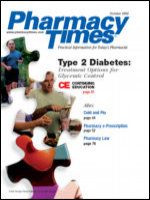Publication
Article
Pharmacy Times
Voriconazole (Vfend)
Author(s):
Introduction
Fungal infections have emerged as important causes of death among immunocompromised patients. Asper-gillosis, in particular, is associated with an increased risk of morbidity and mortality in cancer, transplant, and AIDS patients. Approximately 14% of liver transplant patients, 7% of bone marrow transplant patients, and 14% of leukemia patients may develop invasive aspergillosis. Mortality rates of 45% to 90% attributable to asper-gillosis have been reported in clinical studies, with incidence rising to almost 100% when the central nervous system (CNS) is involved. Amphotericin B has been the cornerstone of treatment for systemic fungal infections. However, that substance has a number of acute and chronic dose-limiting toxicities?in particular, nephrotoxicity. Other FDA-approved antifungal agents (azoles) have a limited spectrum of antifungal activity. Voriconazole (Vfend, Pfizer) was recently approved by the FDA for marketing in the United States for the treatment of invasive aspergillosis and other emerging fungal pathogens. In patients with suspected fungal infections, voricona-zole should be instituted prior to receiving culture results. Treatment should then be adjusted accordingly when cultures are available.1,2
Pharmacology
Voriconazole, a second-generation triazole, was developed to expand the antifungal spectrum of fluconazole. Voriconazole has broad-spectrum coverage for molds, Candida albicans, and non-albicans (glabrata, krusei, parapsilo-sis, and other Candida species). In addition, voriconazole has an excellent efficacy profile for the treatment of other emerging fungal pathogens (Scedosporium and Fusarium). Voricon-azole is available as both intravenous and oral preparations. These formulations allow treatment flexibility in outpatients, improve quality of care, lower overall cost, and allow for prolonged treatment?frequently required in invasive fungal infections?to be given orally.
The pharmacokinetics of voricon-azole are characterized by high oral bioavailability (96%), a large volume of distribution (4.5 L/kg), and elimination through hepatic metabolism by cytochrome P-450 isozymes. This high oral bioavailability allows for switching between intravenous and oral administration. The large volume of distribution of voriconazole indicates extensive tissue distribution with excellent CNS penetration.2,3
Efficacy
The safety and efficacy of voricon-azole in the treatment of fungal infections has been evaluated extensively in several clinical studies. Approximately 2000 patients have been treated with voriconazole for candidemia (albicans and non-albicans), invasive aspergillosis, and neutropenic fever. The drug also has been used in critically ill patients following solid organ transplantation or bone marrow transplantation and in HIV-positive patients. In a comparative clinical study, 392 patients with proven invasive asper-gillosis were randomized to either voriconazole intravenous (IV)/oral or IV amphotericin B. Voriconazole was administered with 2 loading doses of 6 mg/kg IV q 12 h followed by 4 mg/kg q 12 h for at least 7 days followed by oral voriconazole 200 mg bid for up to 12 weeks. Amphotericin B was administered at a dose of 1.0-1.5 mg/kg/day as a slow IV infusion. Providers were allowed to switch amphotericin patients to other licensed antifungal treatments if the initial drug failed or if the patient became intolerant. The researchers found that patients receiving voriconazole were more likely to continue treatment. Significantly better response rates were noted in patients receiving voriconazole, compared with those receiving amphotericin B (53% vs 32%, P < .05). In addition, voriconazole therapy was associated with significantly better survival rates, compared with amphotericin B. This survival benefit has not been reported with any other antifungal therapy, compared with amphotericin B.
In another study, significantly fewer cases of breakthrough invasive fungal infections were experienced in vori-conazole-treated patients, compared with liposomal amphotericin B?treated patients (8 vs 21, respectively), for empiric antifungal therapy in patients with persistent fever and neutropenia.2-4Safety
Available clinical evidence suggests that voriconazole-associated risk includes mild and transient visual abnormalities, hepatic function abnormalities, skin reactions, and potential for drug?drug interactions. Abnormal vision is dose related and was reported in approximately 30% of patients However, altered vision tended to persist for only 30 minutes after the dose, with only 0.5% of patients requiring voriconazole discontinuation.2,3,5
Outlook
Fungal infections occur in severely ill, immunocompromised patients and are associated with high morbidity and mortality. Voriconazole is an effective agent for the treatment of aspergillosis and Candida infections. Voriconazole should be considered in immunocom-promised patients when invasive fungal infection caused by aspergillosis, candidiasis, Scedosporium, or Fusarium is suspected. It also should be considered in documented fungal infections in patients with persistent fever and neutropenia when a broader spectrum of coverage is required than that which fluconazole provides.
For a list of references, send a stamped, self-addressed envelope to: References Department, Attn. D. Campagnola, Pharmacy Times, 241 Forsgate Drive, Jamesburg, NJ 08831; or send an e-mail request to: [email protected].







